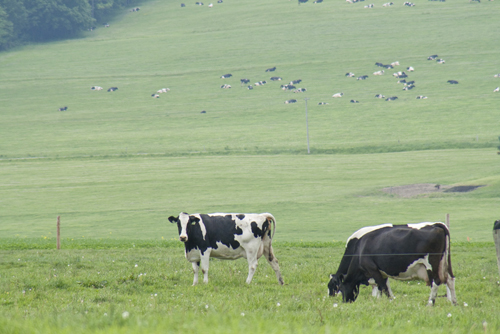In recent years, it seems that more opinions have given credence to the notion that raising high-producing cows in freestall barns, storing manure in lagoons, and storing silage in bunkers are all better for the environment.

The May/June 2011 USDA Agricultural Research Service (ARS) magazine Agricultural Research explained research that was printed in Forage and Grazinglands in 2009, which determined that keeping dairy cows outdoors all year lowered levels of ammonia emission by about 30 percent. When considering land in feed crops were converted to perennial grasslands, carbon sequestration also climbed from 0 in a confined system to 3,400 pounds per acre with all-year-round grazing. Methane, nitrous oxide, and carbon dioxide were also 8 percent lower in all-year pasture versus confinement. Click here for the full article.
This is important and objective research. Of course, those of us in confined systems will quickly note that based on temperatures, precipitation and pasture conditions, and land base (some farmers just cannot afford the land surrounding their farm), pasture just won't always work. At the same time, there are fewer dairy artists selling large quantities of prints with cows lying in free stalls, held in lock-ups, or at the palpation rail compared to pasture. Pasture-based prints sell well and are hung above the farmhouse mantle and in the dairy office. This comes even as we tell consumers that the idyllic "red barn and pasture" scenes are old technology and a thing of the past.
Obviously, due to the concerns listed above, pasture is never always better than a confined operation. At the same time, confined operations also have drawbacks, but they do allow for much better individual attention to cows.
The bottom line here is that this research proves that every operation is different. Making generalizing claims about the environmental "friendliness," cow comfort, or consumer image of a certain type of operation is a bad idea. All farmers should strive to be the best environmental, market (consumer), and cow stewards they can be. But we all started in different places, and we're all going in different directions.
Worry about conditions on your farm first. If you are worried about conditions on other farms, look to the many local, regional, and national dairy farmer boards to get involved.

The May/June 2011 USDA Agricultural Research Service (ARS) magazine Agricultural Research explained research that was printed in Forage and Grazinglands in 2009, which determined that keeping dairy cows outdoors all year lowered levels of ammonia emission by about 30 percent. When considering land in feed crops were converted to perennial grasslands, carbon sequestration also climbed from 0 in a confined system to 3,400 pounds per acre with all-year-round grazing. Methane, nitrous oxide, and carbon dioxide were also 8 percent lower in all-year pasture versus confinement. Click here for the full article.
This is important and objective research. Of course, those of us in confined systems will quickly note that based on temperatures, precipitation and pasture conditions, and land base (some farmers just cannot afford the land surrounding their farm), pasture just won't always work. At the same time, there are fewer dairy artists selling large quantities of prints with cows lying in free stalls, held in lock-ups, or at the palpation rail compared to pasture. Pasture-based prints sell well and are hung above the farmhouse mantle and in the dairy office. This comes even as we tell consumers that the idyllic "red barn and pasture" scenes are old technology and a thing of the past.
Obviously, due to the concerns listed above, pasture is never always better than a confined operation. At the same time, confined operations also have drawbacks, but they do allow for much better individual attention to cows.
The bottom line here is that this research proves that every operation is different. Making generalizing claims about the environmental "friendliness," cow comfort, or consumer image of a certain type of operation is a bad idea. All farmers should strive to be the best environmental, market (consumer), and cow stewards they can be. But we all started in different places, and we're all going in different directions.
Worry about conditions on your farm first. If you are worried about conditions on other farms, look to the many local, regional, and national dairy farmer boards to get involved.








